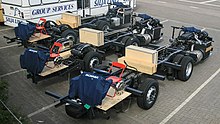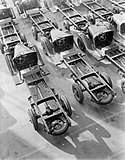Rolling chassis
A rolling chassis is the chassis without bodywork of a motor vehicle (car, truck, bus, or other vehicle), assembled with its final powertrain (engine and drivetrain), and able to move under its own power.
Heavy vehicles


Separate chassis remain in use for almost all heavy vehicles ranging from pickup trucks to the biggest trucks and commercial passenger carrying vehicles.
The rolling chassis is delivered to the commercial body maker, coachbuilder, or bulk transporter on its own wheels, under its own power.
Automobiles
Rolling chassis was a stage of manufacture of every vehicle until automobile construction methods changed when unibody or monocoque combined chassis and body structures gradually replaced chassis.
Restoration
In restoration circles rolling chassis is a name given to a bodyshell with wheels and suspension but without engine and transmission.
- Some automobile chassis
-
Rolling X-frame chassis
-
Rolling platform frame 1965 Miura
-
Rolling platform frame AK 427 Cobra replica rolling chassis
-
Old-fashioned space frame Mercedes 300 SL Gullwing W180
-
Current unified body and chassis frame Mercedes SLS R197
See also
![]() Media related to Rolling chassis at Wikimedia Commons
Media related to Rolling chassis at Wikimedia Commons
- Glider (automobiles), an otherwise complete motor vehicle that lacks some or all of the powertrain





